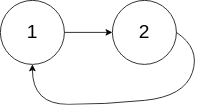题目描述
给定一个链表,判断链表中是否有环。
为了表示给定链表中的环,我们使用整数
pos来表示链表尾连接到链表中的位置(索引从 0 开始)。 如果pos是-1,则在该链表中没有环。示例 1:
输入:head = \[3,2,0,-4], pos = 1 输出:true 解释:链表中有一个环,其尾部连接到第二个节点。
示例 2:
输入:head = \[1,2], pos = 0 输出:true 解释:链表中有一个环,其尾部连接到第一个节点。
示例 3:
输入:head = \[1], pos = -1 输出:false 解释:链表中没有环。
进阶:
你能用 O(1)(即,常量)内存解决此问题吗?
解题思路
如果一个链表中出现了环,我们在进行遍历时就会有重复的元素出现,那么可以使用哈希表来实现。
哈希表
|
|
使用哈希表的空间复杂度为O(n)
双指针
使用双指针可以实现O(1)的空间复杂度,因为如果链表有环,我们使用两个速度不同的指针,那么它两个最终都会相遇,如果没有环,那快指针会先到达终点。
|
|


